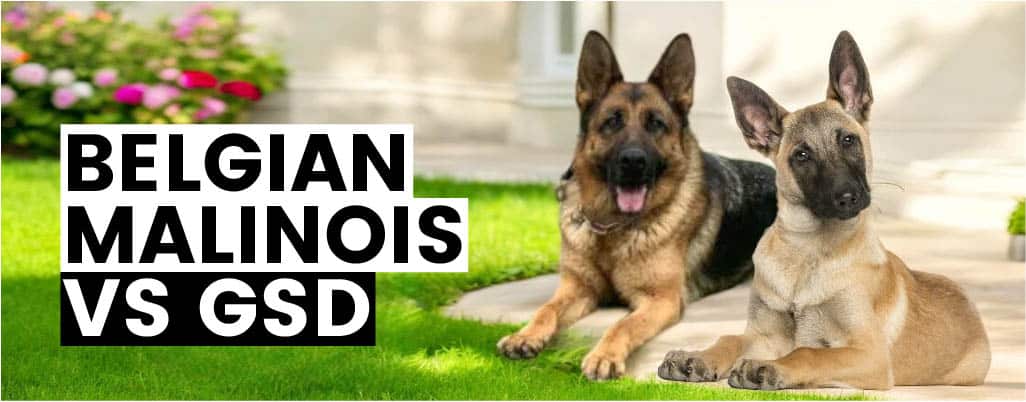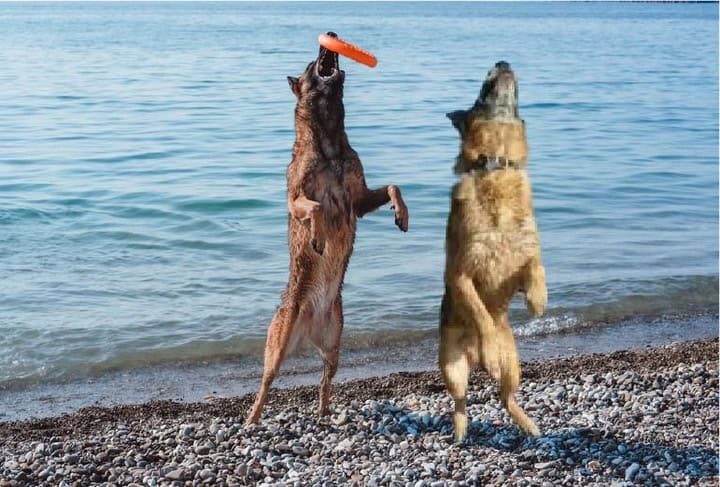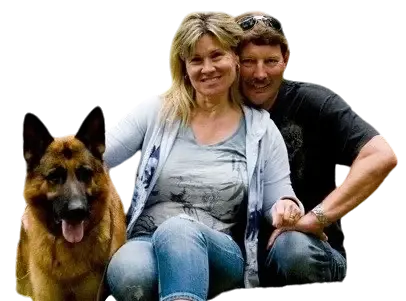
German Shepherd vs Belgian Malinois — Confused between these two breeds?
Choosing between these two sharp and loyal breeds is not that easy. While both excel in loyalty and protection, the decision should align with your lifestyle, experience level, and the time you can commit to training and exercise.
Belgian Malinois and German Shepherds share many similarities but also have unique traits that set them apart. And before selecting one, you need to know about every aspect that makes these two breeds different. Let’s get started!
SUMMARY
- German Shepherd vs Belgian Malinois’ distinct traits and behaviors include their energy levels, intelligence, and temperament.
- Each breed’s training requirements and exercise demands ensure they fit well with your lifestyle and capabilities.
- Each breed excels in specific roles and environments, such as family pets, working dogs, or service animals.
- Compare how each breed adapts to different living situations and their grooming needs to make an informed choice.
Quick Comparison – Belgian Malinois vs GSD
Here is a quick comparison of both breeds to make your decision easy.
| Aspect | Belgian Malinois 🐾 | German Shepherd (GSD)🐾 |
|---|---|---|
| Energy Level | Extremely high, requires lots of exercise | High, enjoys exercise but can relax |
| Size | Medium, 60-80 pounds, 22-26 inches tall | Large, 65-90 pounds, 22-26 inches tall |
| Living Environment | Best in homes with lots of space and activity | Adaptable to various living conditions |
| Grooming Needs | Low to moderate, short coat | Moderate, dense double coat |
| Coat Type | Short, dense, and straight | Medium-length, double-coat |
| Roles | Police, military, detection, agility sports | Service, military, family pet, search and rescue |
| Lifespan | 12-14 years | 10-13 years |
| Social Behavior | Wary of strangers, needs early socialization | Aloof but friendly, good with socialization |
Detailed Overview of Differences Between Belgian Malinois and German Shepherd

Here is a detailed difference between German Shepherd vs Belgian Malinois.
1. Physical Appearance:
The German Shepherd is a larger and more imposing breed, standing between
- 22-26 inches in height
- weighing between 50-90 pounds
Its robust and muscular build is complemented by a characteristic sloped back, giving it a powerful and authoritative presence. The coat of a German Shepherd is medium-length and dense, coming in colors such as black and tan, ebony, and solid black. This breed’s robust physique and commanding appearance enhance its functionality as a working dog and make it a highly effective protector and companion.
The Belgian Malinois is a medium-sized breed, generally standing between
CALL Michael and Jeannette Today!
Your Loyal German Shepherd is Just a Call Away – Purebred and Ready for Your Family!

- 22-26 inches tall at the shoulder
- weighing between 40-80 pounds
Its build is compact and athletic, reflecting its agility and speed. The Malinois has a sleek, short coat that typically comes in shades of fawn to mahogany with a distinctive black mask. While its physical appearance is striking and agile, it is somewhat less imposing than the German Shepherd, which has a more robust and commanding presence.
2. Temperament: German Shepherd vs Belgian Malinois
Belgian Malinois are known for their incredibly high energy levels and intense drive. They require extensive physical and mental stimulation to thrive, often needing several hours of exercise and daily active play. Their high energy can make them somewhat challenging for less experienced owners.
While their alert and intelligent nature is impressive, they also need constant engagement and purpose to prevent boredom and ensure they are content and well-behaved.
German Shepherds have a high energy level, but their adaptability makes them somewhat easier to manage than the Malinois. They enjoy regular exercise but can be content with a balanced routine that includes both physical activity and mental stimulation.
Their loyal and courageous nature makes them highly versatile, allowing them to excel in a variety of roles, from family companions to service dogs. Their ability to adjust to different activity levels means they can fit well into both active and more relaxed households.
3. Trainability: GSD vs Belgian Malinois
The Belgian Malinois is renowned for its high trainability. This breed’s exceptional focus and drive make it excel in
- advanced elite training
- specialized roles
Its intelligence allows it to quickly learn and execute complex tasks, often leading to its use in demanding positions like search and rescue or military operations. However, due to its high energy and drive, consistent training and mental stimulation are essential to keep it well-behaved and happy.
German Shepherds are also highly trainable and known for their adaptability to various training environments. They are eager to please and can excel in:
- Essential Obedience Training
- Service Work
- Protection Tasks
Their balanced approach to training allows them to learn quickly while remaining responsive to commands. Their versatility makes them suitable for various roles, from family pets to professional working dogs, highlighting their strong work ethic and intelligence.
4. Health Considerations – Belgian Malinois vs German Shepherd Dogs
Belgian Malinois are generally healthy, but they are prone to genetic predispositions such as
- hip dysplasia
- Certain eye conditions
- Bloat
- Epilepsy
Regular veterinary care and attention to their active lifestyle are important to manage these risks. Their high energy levels and active nature can sometimes contribute to stress-related issues if not properly managed. Ensuring they receive proper care and regular check-ups is essential for maintaining their overall well-being.
German Shepherds face several health concerns and are also susceptible to genetic conditions like
- hip and elbow dysplasia,
- bloat
- degenerative myelopathy
However, their strong health can often be maintained through regular veterinary care, responsible breeding practices, and careful attention to their exercise and dietary needs. Their active lifestyle benefits from proactive health management, which helps them remain healthy and functional throughout their lives, making them resilient and dependable companions.
Also Read: How To Position GSD Hips Fro X-ray?
5. Best Living Conditions – Malinois vs GSD
Belgian Malinois excel in environments that cater to their high energy and intelligence. They thrive in active households with ample space for physical activities, such as homes with large yards or access to agility training facilities. These dogs require substantial mental stimulation and exercise, making them ideal for individuals or families who can dedicate time to interactive play, training, and engaging activities.
Their vibrant and demanding nature means they are best suited for experienced dog owners who can manage their energetic disposition and provide structured routines. Homes with a lot of space for exercise and tasks challenging their intellect, such as agility courses or advanced obedience training, are perfect for keeping a Belgian Malinois happy and healthy.
German Shepherds are remarkably adaptable and can thrive in various living conditions. Whether in urban apartments or rural homes, they adjust well as long as their exercise and mental stimulation needs are met. Their balanced energy levels and calm demeanor make them versatile for various environments, from bustling households to serene settings. German Shepherds can comfortably fit into
- active families
- single households
- quieter homes
as long as they receive regular exercise and mental engagement. Their versatility makes them an ideal companion for those seeking a dependable and adaptable dog who can seamlessly integrate into different lifestyles and living situations.
6. Specializations and Strengths – GSD vs Malinois
Belgian Malinois are highly specialized for demanding roles such as
- police work
- military service
- Search
- rescue operations
Their exceptional agility, keen senses, and intense drive make them ideal for tasks requiring high levels of precision and focus. While their specialized skills are impressive, they often require experienced handlers to fully harness their potential. Their performance in these roles underscores their effectiveness but also highlights their need for careful management and training.
German Shepherds are renowned for their remarkable versatility and excel in a wide array of roles, including
- police
- military work
- service dog tasks
- therapy work
- Search
- rescue
Their balanced temperament, intelligence, and strong protective instincts make them highly effective in both familial and professional settings. Their adaptability and broad skill set make them a top choice for various applications, showcasing their ability to perform exceptionally well in diverse environments and roles.
7. Socialization Needs – Belgian Malinois vs German Shepherds
Belgian Malinois need extensive and early socialization to develop into well-adjusted adults. Their high energy and intelligence mean they can be reserved or aloof if not adequately exposed to various people, animals, and situations.
Early socialization helps mitigate potential behavioral issues and ensures they interact positively in different environments. While they can become excellent companions, their socialization requirements are significant and necessitate dedicated effort from their owners. German Shepherds generally have a more open and adaptable nature regarding socialization.
They typically respond well to early exposure to different people and animals, which helps them develop into confident and balanced adults. Their natural friendliness and protective instincts, combined with proper socialization, enable them to interact well in various social situations. Their more adaptable nature often makes it easier for them to socialize, contributing to their effectiveness as family and working dogs.
8. Exercise Requirements – German Shepherds vs BMs
Belgian Malinois requires exceptionally high exercise to stay healthy and happy. They thrive on
- vigorous running
- agility training
- interactive play
CALL Michael and Jeannette Today!
Train with the Best – Elite German Shepherd Schutzhund/IPO Training in Los Angeles!

Their high energy can lead to behavioral problems if they do not receive adequate exercise and mental stimulation. Meeting their rigorous exercise needs is crucial for their well-being, ensuring they remain engaged and content. Their intense activity requirements make them well-suited for active and experienced dog owners.
German Shepherds have high exercise needs but are more adaptable than the Belgian Malinois. They enjoy various activities, such as
- jogging
- hiking
- playing fetch
While they benefit from regular exercise, they can be satisfied with a balanced physical and mental stimulation routine. Their ability to adjust to different activity levels makes them versatile companions, fitting well into active, more relaxed lifestyles.
9. Grooming Needs – GSDs vs Belgian Malinois
The Belgian Malinois has relatively low grooming needs due to its short, dense coat. Regular brushing helps manage shedding and maintain coat health, while occasional baths keep them clean.
Their grooming requirements are straightforward compared to longer-coated breeds, making maintenance relatively easy. Their minimal grooming needs align well with their active lifestyle, ensuring that their physical care does not become overly burdensome for their owners.
Due to their dense double coat, German Shepherds have moderate to high grooming needs. Regular brushing is essential to manage shedding and prevent matting, particularly during seasonal changes. Their grooming routine may require more time and effort compared to shorter-coated breeds. Despite the additional grooming needs, their loyal and adaptable nature often makes the extra care worthwhile, ensuring their coat remains healthy and in optimal condition.
10. Spaying or Neutering: GSDs vs BMs
The high energy and strong working drive Belgian Malinois benefit from careful timing when spaying or neutering. Early spaying or neutering can sometimes impact the development of their joints and bones, given their active nature and the physical demands often placed on them. Some experts recommend waiting until the Malinois reaches at least 18 months of age before undergoing the procedure to allow their bodies to develop fully.
This cautious approach can help maintain their agility and reduce the risk of joint issues later in life, ensuring they remain fit for the intense physical activities they excel in.
For German Shepherds, spaying or neutering is a significant decision that should be timed thoughtfully. As a giant breed prone to conditions like hip dysplasia, there are concerns that early spaying or neutering might exacerbate these issues. Many veterinarians and breeders suggest waiting until the German Shepherd is over two years of age before spaying or neutering them.
This timing allows for more complete physical development, reducing potential risks associated with skeletal growth. Given their popularity as family pets and working dogs, spaying or neutering at the right time helps promote their long-term health and contributes to their ability to lead active, healthy lives.
Related Article: Risks Associated with Spaying/Neutering in GSDs
German Shepherd vs Belgian Malinois – Which is Better?
Choosing between a Belgian Malinois and a German Shepherd depends on your lifestyle and needs.
If you seek a high-energy, agile, and work-driven dog for activities like agility training, protection work, or law enforcement, the Belgian Malinois is an excellent choice. Their intense drive, agility, and focus make them ideal for high-demand environments requiring constant physical activity.
On the other hand, if you’re looking for a versatile family companion that’s protective yet more adaptable to various living situations, the German Shepherd may be more suitable. While both breeds excel in loyalty and protection, the decision should align with your lifestyle, experience level, and the time you can commit to training and exercise.
Before making a final decision, consider visiting breeders, meeting both breeds in person, and speaking with trainers or owners. Understanding each breed’s needs and characteristics firsthand will help ensure you choose the right companion to match your lifestyle and expectations.
FAQs
Does the Military use German Shepherds or Belgian Malinois?
The military uses both German Shepherds and Belgian Malinois. However, Belgian Malinois are often preferred due to their smaller size, agility, and intense drive, making them ideal for specialized tasks like detection, tracking, and protection work.
Which Breed is More Suitable for First-Time Dog Owners?
German Shepherds are generally considered more suitable for first-time dog owners due to their adaptability and easier training. They tend to be more forgiving of inexperienced handling and are known for their loyalty and protective nature, making them excellent companions. Belgian Malinois, with their high energy levels and need for constant mental stimulation, might be more challenging for novice owners.
Which Breed is More Prone to Separation Anxiety?
Both breeds are known to be loyal and attached to their owners, which can lead to separation anxiety if left alone for extended periods. However, Belgian Malinois may be more prone to separation anxiety due to their high energy levels and constant need for mental.
If you are considering adding GSD to your family and need expert training for your German Shepherd, contact us for top-rated German Shepherd training services. Our experienced team specializes in breeding, training, and providing top-quality German Shepherds that excel in both work and companionship.






